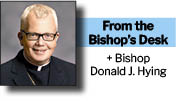
Several weeks ago, the cloistered Cistercian Sisters in our diocese, who have been living in their monastery at Prairie du Sac since the 1950’s, moved to their new home in rural Iowa County, south of Barneveld.
The monumental efforts undertaken by the Sisters to raise the needed funds and complete the construction of the new monastery, under the challenges of COVID-related difficulties, have borne great fruit, as the new site is beautiful, solitary, and contemplative.
Many thanks to everyone, especially the generous benefactors, who have helped in this noble endeavor!
The remodeling of St. Bernard Parish in Madison as our new diocesan cathedral continues.
In the process of the work, we discovered that the original floor of the church was in need of complete replacement; the new one was poured just before Easter.
Reworking this beautiful Church from the ground up, this major effort demonstrates that the structural and aesthetic needs of a cathedral are greater than an average Church, so we are investing wisely to ensure that we have a beautiful and accessible one for decades to come.
I hope that the Cathedral of St. Bernard of Clairvaux will be dedicated in the latter half of 2025.
Many thanks to everyone, especially the generous benfactors, who have helped in this beautiful work!
The importance of institutions within the Church
The concurrence of these two significant projects led me to wonder how many dioceses are currently building a new cathedral and a new contemplative monastery at the same time.
Sadly, many monasteries and convents are closing, both in our country and in the West in general, because of the dearth of new members. Few new ones are being built.
Every diocese has a cathedral, often historic and well-established, so the opportunity to create a new one is an extremely rare occurrence. We are blessed in this remarkable moment to witness and support the building of these two important structures.
The institutions of cathedrals and monasteries are significant elements of the Church’s life and mission.
In the Middle Ages, the liturgy, education, culture, the arts, and the preservation of ancient knowledge all flourished in these holy places.
As the cathedra or “chair” of the local bishop, the cathedral served, as it does today, as the mother Church of a diocese.
The site of ordinations, majestic Masses, Vespers services, and even coronations of kings and queens, the cathedral was a beautiful architectural jewel which lifted the People of God to the transcendence and majesty of God Himself, especially in the celebration of the Mass.
All over Europe, in the late Middle Ages, magnificent cathedrals rose as a testimony to the faith of the Church and the primacy of God in society.
Anyone who has visited Notre Dame or Chartres in France, St. John Lateran in Rome or the Duomo in Florence, or the cathedrals in Cologne or Burgos knows well the mediating power of these magnificent structures.
As the Church emerged from the time of persecution and martyrdom, when Christianity moved from being illegal to legal to being the official religion of the Roman Empire, many believers sought to embrace a more radical Gospel life, akin to the sacrifice of the martyrs.
Both men and women by the thousands went off to deserted places to live a contemplative solitude in union with God.
St. Anthony of Egypt in the East and St. Benedict in the West simply sought personal holiness in the wilderness, but soon, communities of like-minded individuals arose about them, and so monasticism was born.
By the Middle Ages, thousands of monasteries of both monks and Nuns dotted the map of Europe, where a life of prayer, silence, and manual labor, governed by a communal rule, allowed holiness, order, structure, and culture to flourish in some very challenging centuries of war, chaos, and poverty.
The monasteries preserved the learning of the ancient Romans and Greeks; developed medicine, agriculture, art, and book-making; and fostered education.
Think of the monks in their scriptorium painstakingly copying ancient manuscripts, including Bibles and Psalters, onto parchment with quill pens.
These holy sanctuaries also became places of refuge, shelter, and support during times of violence, famine, and disturbance.
Modern Catholicism
We 21st century American Catholics live in a completely different reality in many ways from a Catholic in medieval Europe, yet the fundamentals of our faith remain the same.
The Scriptures, the Sacraments, the moral life, the importance of the Virgin Mary and the saints, and most of all, the primacy and efficacy of Jesus Christ, crucified and risen, as the source of our salvation, have not changed at all.
The twin institutions of the cathedral and the monastery, which in many aspects, held both the Church and the society together in former centuries, still serve us well in our Catholic discipleship. They both thrive as sacred places where the People of God live out their love for the Lord in prayer and work, in sacrament and charity.
Standing in the midst of the city, the cathedral points the human heart to the centrality of God amid worldly concerns; built in a solitary place, the monastery directs us to find God in solitude and silence, as so many monks and Nuns have discovered in the course of the rich history of our beautiful and wondrous Catholic faith.
How blessed we are to have both a new cathedral and a new monastery here in our diocese, poised to flourish for the salvation of the world, for decades to come!

